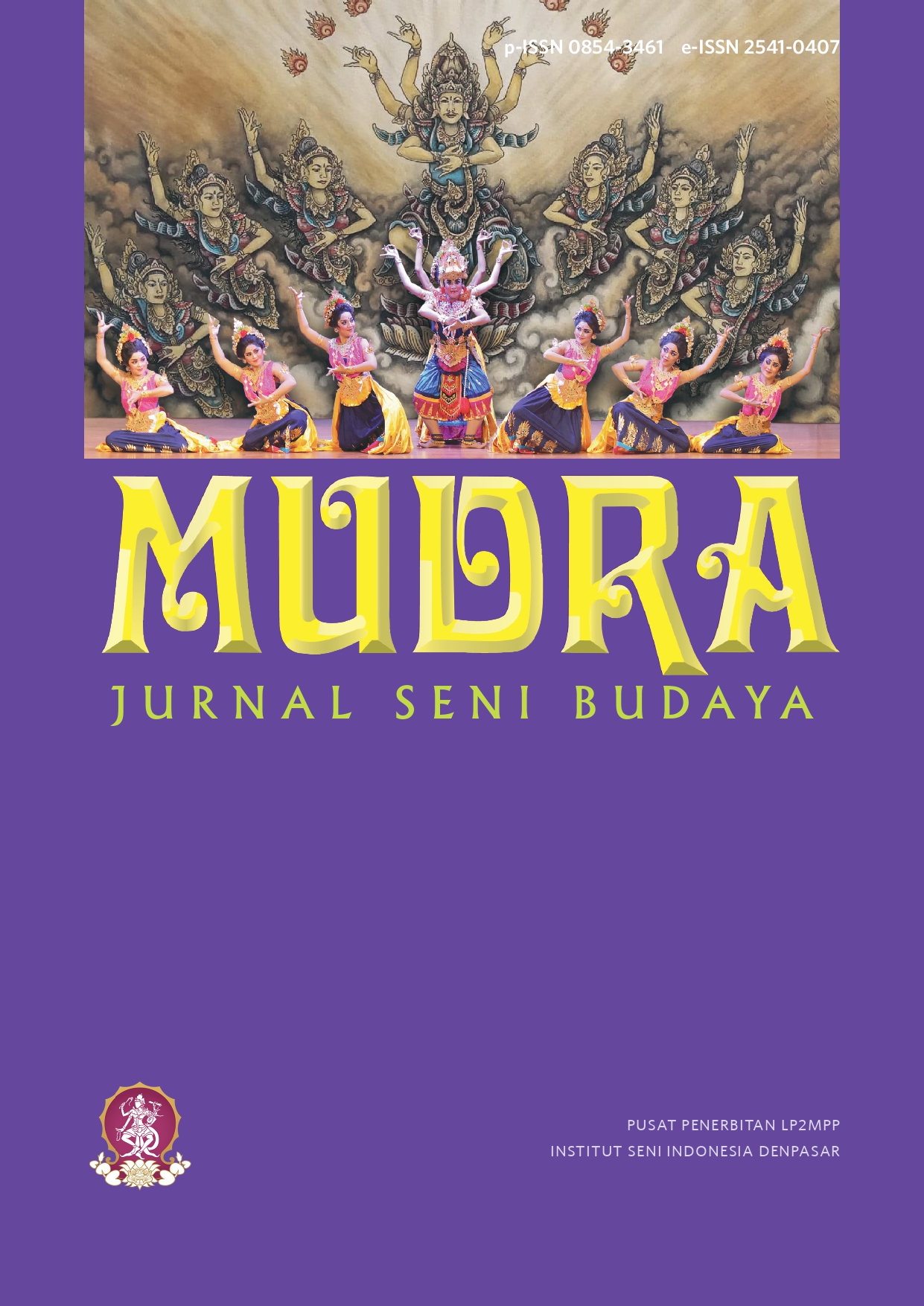Tari Baris Gede Télék at Pura Dalem Kedewatan Desa Adat Sanur: A Study of Form and Function
DOI:
https://doi.org/10.31091/mudra.v38i3.2351Keywords:
Study of Form and Function, Culture, Baris Gede Télék DanceAbstract
The people of Sanur Traditional Village preserve culture through a process of solidarity, meaning the process between the dance performance of Baris Gede Télék as a local art entity and the local community as its supporters who are faced with something sublimation. The sublimation in question is a process of adjusting society to the development of newer times, but not abandoning existing art. The focus of this research is the form and function of Baris Gede Télék dance. The purpose of this research is to increase understanding and awareness of Balinese art, especially in Baris Gede Télék dance in life, which will basically always exist and remain sustainable. The method used as the basis for the analysis stage is a qualitative method that is descriptive-analytical by identifying and describing a phenomenon that occurs in the field as it is. The sources presented in this paper are obtained from direct observation, then an interview was conducted with the relevant informant, and deepened by the study of documents obtained from a collection of archives, books, videos, and audio recordings related to Baris Télék dance. The collected data is then analyzed through the stages of data reduction, data presentation, and data verification before the data is concluded. With the application in the cultural inheritance space, the people of Sanur Traditional Village are expected to be able to be faced with a process of educating the self-awareness of the community as cultural supporters in the context of directing art, so as to form a character value that will have a major influence on the development of the local community.
Downloads
References
Bandem, I Made. (1975). The Baris Dance. Ethnomusicology: Journal of The Society of Ethnomusicology, 9(2), 259–265. https://doi.org/10.2307/850359.
Cahyono, Agus. (2006). Seni Pertunjukan Arak-arakan dalam Upacara Tradisional Dugdheran di Kota Semarang. Harmonia: Journal of Arts Research and Education, 7(3), 1–11.
Covarrubias, M. (1974). Island of Bali. Kuala Lumpur: Oxford University Press.
Dibia, I Wayan. (1985). Odalan of Hindu Bali: a Social Religius Festival, and Theatrical Event. Asian Theatre Journal, 2(1), 61–65. https://doi.org/10.2307/1124507
Dibia, I Wayan. (2012). Ilen-Ilen Seni Pertunjukan Bali. Denpasar: UPT. Penerbit ISI Denpasar.
Dibia, I Wayan. (2013). Puspasari Seni Tari Bali. Denpasar: UPT. Penerbit ISI Denpasar.
Jazuli, Muhammad. (2014). Sosiologi Seni: Pengantar dan Model Studi Seni, Edisi 2. Yogyakarta: Graha Ilmu.
Jazuli, Muhammad. (2015). Aesthetics of Prajuritan Dance in Semarang Regency. Harmonia: Journal of Arts Research and Education, 15(1), 16. https://doi.org/10.15294/harmonia.v15i1.3692
Karmini, Ni Wayan, & Paramartha, W. (2019). Nilai-Nilai Pendidikan dalam Tari Sanghyang Manik Geni di Pura Serayu Desa Adat Canggu, Kuta Utara-Badung. Mudra: Jurnal Seni Budaya, 34(3), 341–348. https://doi.org/10.31091/MUDRA.V34I3.792
Malarsih, M., & Utina, U. T. (2019). Golek Dance: between Surakarta and Mangkunegaran Style. Atlantis Press: Journal of Advances in Social Sciences, Education and Humanities Research, 271(2018), 75–77. https://doi.org/10.2991/iconarc-18.2019.72
Maro’atussofa, C., & Kusumastuti, E. (2019). Profesionalitas Penari Lengger Grup Pager Tawon Wonosobo. Jurnal Seni Tari, 8(2), 150–160. https://doi.org/10.15294/jst.v8i2.33778
Mulanto, J., & Cahyono, A. (2014). Pewarisan Bentuk, Nilai, dan Makna Tari Kretek. Pewarisan Bentuk, Nilai, Dan Makna Tari Kretek, 3(2), 12.
Soedarsono, R. M. (2002). Seni Pertunjukan Indonesia di Era Globalisasi. Yogyakarta: Gadjah Mada University Press.
Supardan, D. (2016). Teori dan Praktik Pendekatan Konstruktivisme dalam Pembelajaran. Edunomic, 4(1), 1–12. https://www.fkip-unswagati.ac.id/ejournal/index.php/edunomic/article/view/199
Suryawati, Ida Ayu Gede. (2017). Memaknai Tari Baris Sumbu di Pura Desa Semanik, Desa Pelaga, Petang, Kabupaten Badung. Dharmasmrti: Jurnal Ilmu Agama Dan Kebudayaan, 17(2), 48–53. https://doi.org/10.32795/ds.v17i02.88
Sustiawati, Ni Luh, D. (2011). Pengetahuan Seni Tari Bali. Denpasar: PT. Empat Warna Komunikasi.
Thalib, M. A. (2022). Pelatihan Analisis Data Model Miles Dan Huberman Untuk Riset Akuntansi Budaya. Madani: Jurnal Pengabdian Ilmiah, 5(1), 23–33. https://doi.org/10.30603/md.v5i1.2581
Triyanto. (2015). Perkeramikan Mayong Lor Jepara: Hasil Enkulturasi dalam Keluarga Komunitas Perajin. Imajinasi: Jurnal Seni, 9(1), 1–10. https://journal.unnes.ac.id/nju/index.php/imajinasi/article/view/8850
Downloads
Published
How to Cite
Issue
Section
License
Copyright (c) 2023 Anak Agung Made Anom Wira Kusuma, M. Jazuli, Widodo -

This work is licensed under a Creative Commons Attribution-NonCommercial-ShareAlike 4.0 International License.
- Copyright on any open access article in a journal published by Mudra Jurnal Seni Budaya is retained by the author(s).
-
The Creative Commons Attribution License 4.0 formalizes these and other terms and conditions of publishing articles.









